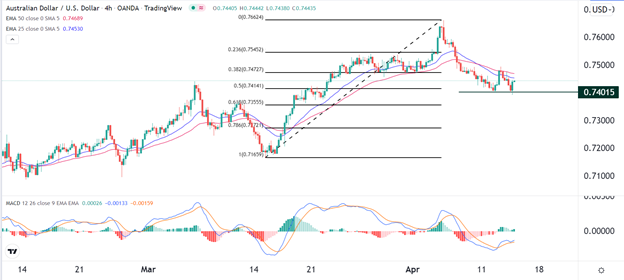Bullish View
- Buy the AUD/USD and set a take-profit at 0.7495.
- Add a stop-loss at 0.7390.
- Timeline: 1-2 days.
Bearish View
- Set a sell-stop at 0.7400 and a take-profit at 0.7300.
- Add a stop-loss at 0.7500.
The AUD/USD pair attempted to recover after the surprise interest rate decisions by the Reserve Bank of New Zealand (RBNZ) and Bank of Canada (BOC). The pair is trading at 0.7440, which is a few points above this week’s low of 0.7395.
More Pressure on RBA
This month, the Reserve Bank of Australia hinted that it will start hiking interest rates in June this year. In the statement, the bank hinted that it was starting to lose patience with its inflation target.
The bank could now come under pressure from other central banks. For example, the Fed has started hiking interest rates and has hinted that it will become more aggressive in the coming months. Analysts expect that the bank will deliver about 6 more hikes this year.
On Wednesday, the RBNZ caught many analysts by surprise when it delivered a bigger hike than expected. It pushed its benchmark interest rate to 1.50% from the previous 1.0% in its biggest rate hike in 22 years.
The BOC also decided to hike interest rates by another 0.50%. Similarly, the BOE has already delivered three rate hikes since December last year. Therefore, analysts believe that the RBA will also become more aggressive in the coming months.
The AUD/USD pair is also reacting to the latest jobs numbers. According to the Statistics Agency, the country’s unemployment rate remained at 4.0% in March. This performance was worse than the median estimate of 3.9%. The economy added 17.9k jobs in March after it added another 77k job in the previous month.
The pair will next react to the latest retail sales and export and import price index data from the United States.
AUD/USD Forecast
The AUD/USD pair declined to a low of 0.7400 this week. A closer look shows that it formed a small double-bottom pattern in this level. On the four-hour chart, the pair is trading at an important level since it was its highest point on March 7th. It is also slightly below the 25-day and 50-day moving averages while the MACD has formed a bullish crossover pattern.
Therefore, the sharp decline will likely take a breather in the coming days. If this happens, the next key resistance will be at 0.7495.

